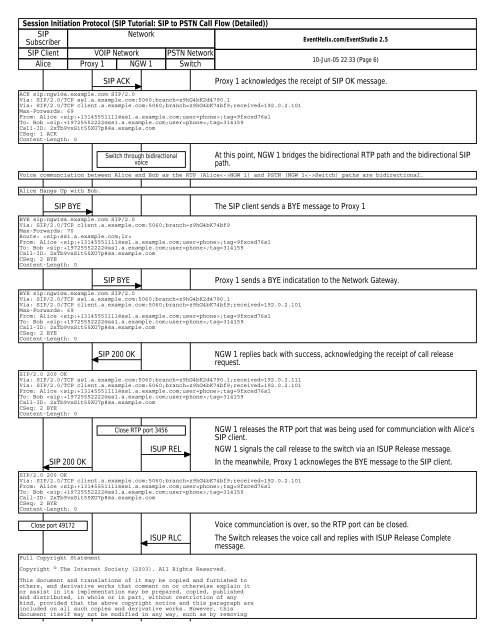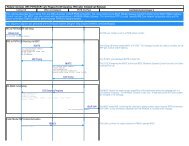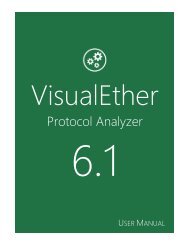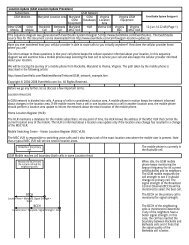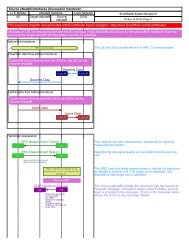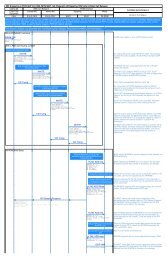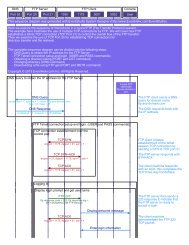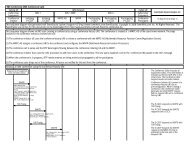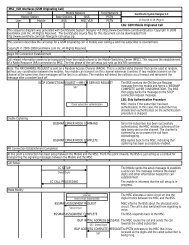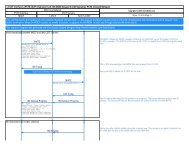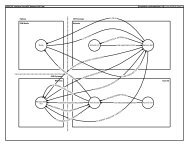SIP Tutorial: SIP to PSTN Call Flow (Detailed) - EventHelix.com
SIP Tutorial: SIP to PSTN Call Flow (Detailed) - EventHelix.com
SIP Tutorial: SIP to PSTN Call Flow (Detailed) - EventHelix.com
Create successful ePaper yourself
Turn your PDF publications into a flip-book with our unique Google optimized e-Paper software.
Session Initiation Pro<strong>to</strong>col (<strong>SIP</strong> <strong>Tu<strong>to</strong>rial</strong>: <strong>SIP</strong> <strong>to</strong> <strong>PSTN</strong> <strong>Call</strong> <strong>Flow</strong> (<strong>Detailed</strong>))<br />
<strong>SIP</strong><br />
Network<br />
Subscriber<br />
<strong>SIP</strong> Client VOIP Network <strong>PSTN</strong> Network<br />
Alice Proxy 1 NGW 1 Switch<br />
<strong>EventHelix</strong>.<strong>com</strong>/EventStudio 2.5<br />
10-Jun-05 22:33 (Page 6)<br />
<strong>SIP</strong> ACK<br />
Proxy 1 acknowledges the receipt of <strong>SIP</strong> OK message.<br />
ACK sip:ngw1@a.example.<strong>com</strong> <strong>SIP</strong>/2.0<br />
Via: <strong>SIP</strong>/2.0/TCP ss1.a.example.<strong>com</strong>:5060;branch=z9hG4bK2d4790.1<br />
Via: <strong>SIP</strong>/2.0/TCP client.a.example.<strong>com</strong>:5060;branch=z9hG4bK74bf9;received=192.0.2.101<br />
Max-Forwards: 69<br />
From: Alice ;tag=9fxced76sl<br />
To: Bob ;tag=314159<br />
<strong>Call</strong>-ID: 2xTb9vxSit55XU7p8@a.example.<strong>com</strong><br />
CSeq: 1 ACK<br />
Content-Length: 0<br />
Switch through bidirectional<br />
voice<br />
At this point, NGW 1 bridges the bidirectional RTP path and the bidirectional <strong>SIP</strong><br />
path.<br />
Voice <strong>com</strong>munciation between Alice and Bob as the RTP (AliceNGW 1) and <strong>PSTN</strong> (NGW 1Switch) paths are bidirectional.<br />
Alice Hangs Up with Bob.<br />
<strong>SIP</strong> BYE The <strong>SIP</strong> client sends a BYE message <strong>to</strong> Proxy 1<br />
BYE sip:ngw1@a.example.<strong>com</strong> <strong>SIP</strong>/2.0<br />
Via: <strong>SIP</strong>/2.0/TCP client.a.example.<strong>com</strong>:5060;branch=z9hG4bK74bf9<br />
Max-Forwards: 70<br />
Route: <br />
From: Alice ;tag=9fxced76sl<br />
To: Bob ;tag=314159<br />
<strong>Call</strong>-ID: 2xTb9vxSit55XU7p8@a.example.<strong>com</strong><br />
CSeq: 2 BYE<br />
Content-Length: 0<br />
<strong>SIP</strong> BYE<br />
BYE sip:ngw1@a.example.<strong>com</strong> <strong>SIP</strong>/2.0<br />
Via: <strong>SIP</strong>/2.0/TCP ss1.a.example.<strong>com</strong>:5060;branch=z9hG4bK2d4790.1<br />
Via: <strong>SIP</strong>/2.0/TCP client.a.example.<strong>com</strong>:5060;branch=z9hG4bK74bf9;received=192.0.2.101<br />
Max-Forwards: 69<br />
From: Alice ;tag=9fxced76sl<br />
To: Bob ;tag=314159<br />
<strong>Call</strong>-ID: 2xTb9vxSit55XU7p8@a.example.<strong>com</strong><br />
CSeq: 2 BYE<br />
Content-Length: 0<br />
<strong>SIP</strong> 200 OK<br />
<strong>SIP</strong>/2.0 200 OK<br />
Via: <strong>SIP</strong>/2.0/TCP ss1.a.example.<strong>com</strong>:5060;branch=z9hG4bK2d4790.1;received=192.0.2.111<br />
Via: <strong>SIP</strong>/2.0/TCP client.a.example.<strong>com</strong>:5060;branch=z9hG4bK74bf9;received=192.0.2.101<br />
From: Alice ;tag=9fxced76sl<br />
To: Bob ;tag=314159<br />
<strong>Call</strong>-ID: 2xTb9vxSit55XU7p8@a.example.<strong>com</strong><br />
CSeq: 2 BYE<br />
Content-Length: 0<br />
<strong>SIP</strong> 200 OK<br />
Close RTP port 3456<br />
ISUP REL<br />
<strong>SIP</strong>/2.0 200 OK<br />
Via: <strong>SIP</strong>/2.0/TCP client.a.example.<strong>com</strong>:5060;branch=z9hG4bK74bf9;received=192.0.2.101<br />
From: Alice ;tag=9fxced76sl<br />
To: Bob ;tag=314159<br />
<strong>Call</strong>-ID: 2xTb9vxSit55XU7p8@a.example.<strong>com</strong><br />
CSeq: 2 BYE<br />
Content-Length: 0<br />
Close port 49172<br />
Full Copyright Statement<br />
ISUP RLC<br />
Copyright © The Internet Society (2003). All Rights Reserved.<br />
This document and translations of it may be copied and furnished <strong>to</strong><br />
others, and derivative works that <strong>com</strong>ment on or otherwise explain it<br />
or assist in its implementation may be prepared, copied, published<br />
and distributed, in whole or in part, without restriction of any<br />
kind, provided that the above copyright notice and this paragraph are<br />
included on all such copies and derivative works. However, this<br />
document itself may not be modified in any way, such as by removing<br />
Proxy 1 sends a BYE indicatation <strong>to</strong> the Network Gateway.<br />
NGW 1 replies back with success, acknowledging the receipt of call release<br />
request.<br />
NGW 1 releases the RTP port that was being used for <strong>com</strong>munciation with Alice's<br />
<strong>SIP</strong> client.<br />
NGW 1 signals the call release <strong>to</strong> the switch via an ISUP Release message.<br />
In the meanwhile, Proxy 1 acknowleges the BYE message <strong>to</strong> the <strong>SIP</strong> client.<br />
Voice <strong>com</strong>munciation is over, so the RTP port can be closed.<br />
The Switch releases the voice call and replies with ISUP Release Complete<br />
message.


